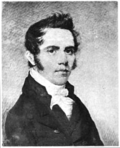
Abel Bowen (1790-1850) was an engraver, publisher, and author in early 19th-century Boston, Massachusetts.

Abel Bowen (1790-1850) was an engraver, publisher, and author in early 19th-century Boston, Massachusetts.
Bowen was born in New York in 1790. [1] Arriving in Boston in 1812, he worked as a printer for the Columbian Museum, at the time under the proprietorship of his uncle, Daniel Bowen. [2] In 1814 Abel married Eliza Healey of Hudson, New York. [3] Their children included Abel Bowen (d.1818). [4]
With W.S. Pendleton he formed the firm of Pendleton & Bowen, which ended in 1826. [5] He joined the Massachusetts Charitable Mechanic Association in 1828. [6] In the 1830s Bowen and others formed the Boston Bewick Company, which published the American Magazine of Useful and Entertaining Knowledge . He lived and worked in Congress Square, ca.1823-1826; [7] in 1832 he kept his shop on Water Street, and lived on Union Street; [8] in 1849 he worked on School Street, and lived in Chelsea. [9]
Bowen taught Joseph Andrews, Hammatt Billings, George Loring Brown, B.F. Childs, William Croome, Nathaniel Dearborn, G. Thomas Devereaux, Alonzo Hartwell, Samuel Smith Kilburn, and Richard P. Mallory. [10] [11] Contemporaries included William Hoogland. [12] His siblings included publisher Henry Bowen.
{{cite book}}: CS1 maint: location missing publisher (link)